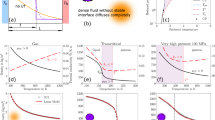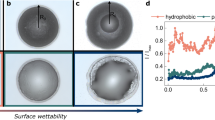Abstract
ALTHOUGH emulsions of immiscible liquids are thermo-dynamically unstable, it is well known that the rate of coalescence may be reduced by adding small quantities of a third component (stabilizer) which is tensioactive. Many theories have tried to explain emulsion stability but none has been perfectly general. The most general theory is based on the stabilization of thin liquid films during approach of droplets as a result of the Gibbs–Marangoni effect1. This stabilizing effect may operate during the early stages of emulsion formation. Electrical repulsion must be a barrier to coalescence in emulsions stabilized by ionized detergents2, but many emulsions of high stability may be prepared in which no electrical potential barrier is believed to be present. The purely hypothetical “solvation barriers”3 cannot explain the stability of water/oil emulsions where the oil is a paraffin, for example, in which no orientation at the interfaces would be expected. A barrier resulting from the high viscosity of the stabilizing film4 cannot account for the high stability of emulsions stabilized by monolayers which do not increase the interfacial viscosity. The difficulty of flow of the continuous medium from thin films between approaching droplets results in a hydrodynamic barrier which would not be expected to be influenced very greatly by the presence of adsorbed monolayers. These latter two mechanisms do not offer an explanation of emulsion type.
This is a preview of subscription content, access via your institution
Access options
Subscribe to this journal
Receive 51 print issues and online access
$199.00 per year
only $3.90 per issue
Buy this article
- Purchase on Springer Link
- Instant access to full article PDF
Prices may be subject to local taxes which are calculated during checkout
Similar content being viewed by others
References
van den Tempel, M., Proc. Third Intern. Cong. Surface Activity, 2, 573 (Cologne, 1960).
Davies, J. T., and Rideal, E. K., in Interfacial Phenomena, 367 (Academic Press, 1961).
Davies, J. T., and Rideal, E. K., in Interfacial Phenomena, 369 (Academic Press, 1961).
Nielson, L. E., Wall, R., and Adams, G., J. Colloid Sci., 13, 441 (1958).
Glasstone, S., Laidler, K. J., and Eyring, H., in The Theory of Rate Processes (McGraw-Hill, 1941).
Bancroft, W. D., J. Phys. Chem., 17, 514 (1913).
Alexander, A. E., in Adv. in Colloid Science, 3, (Interscience Publishers Inc., New York, 1950).
Schulman, J. H., and Cockbain, E. G., Trans. Faraday Soc., 36, 651 (1940).
Lawrence, A. S. C., and Mills, O. S., Disc. Faraday Soc., 18, 98 (1954).
Author information
Authors and Affiliations
Rights and permissions
About this article
Cite this article
MACRITCHIE, F. Barrier to Coalescence in Stabilized Emulsions. Nature 215, 1159–1160 (1967). https://doi.org/10.1038/2151159a0
Received:
Issue Date:
DOI: https://doi.org/10.1038/2151159a0
Comments
By submitting a comment you agree to abide by our Terms and Community Guidelines. If you find something abusive or that does not comply with our terms or guidelines please flag it as inappropriate.



